Input interpretation

Cl_2 chlorine + NaOH sodium hydroxide + NaNO_2 sodium nitrite ⟶ H_2O water + NaCl sodium chloride + NaNO_3 sodium nitrate
Balanced equation
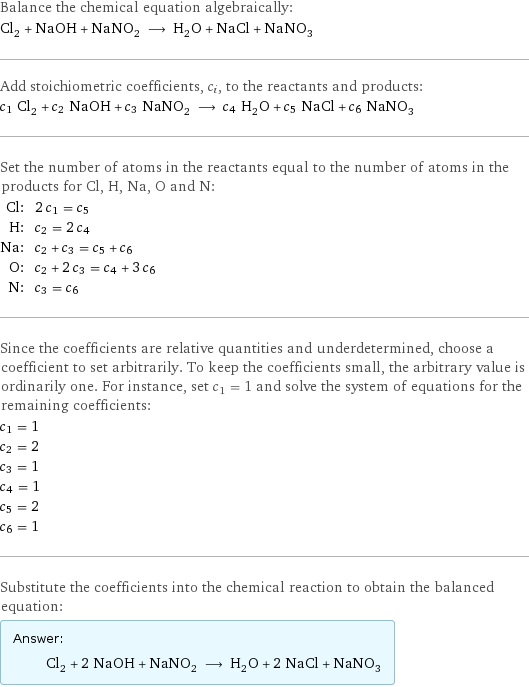
Balance the chemical equation algebraically: Cl_2 + NaOH + NaNO_2 ⟶ H_2O + NaCl + NaNO_3 Add stoichiometric coefficients, c_i, to the reactants and products: c_1 Cl_2 + c_2 NaOH + c_3 NaNO_2 ⟶ c_4 H_2O + c_5 NaCl + c_6 NaNO_3 Set the number of atoms in the reactants equal to the number of atoms in the products for Cl, H, Na, O and N: Cl: | 2 c_1 = c_5 H: | c_2 = 2 c_4 Na: | c_2 + c_3 = c_5 + c_6 O: | c_2 + 2 c_3 = c_4 + 3 c_6 N: | c_3 = c_6 Since the coefficients are relative quantities and underdetermined, choose a coefficient to set arbitrarily. To keep the coefficients small, the arbitrary value is ordinarily one. For instance, set c_1 = 1 and solve the system of equations for the remaining coefficients: c_1 = 1 c_2 = 2 c_3 = 1 c_4 = 1 c_5 = 2 c_6 = 1 Substitute the coefficients into the chemical reaction to obtain the balanced equation: Answer: | | Cl_2 + 2 NaOH + NaNO_2 ⟶ H_2O + 2 NaCl + NaNO_3
Structures
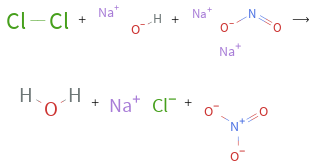
+ + ⟶ + +
Names

chlorine + sodium hydroxide + sodium nitrite ⟶ water + sodium chloride + sodium nitrate
Reaction thermodynamics
Enthalpy
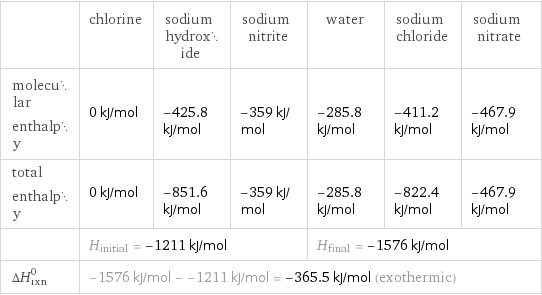
| chlorine | sodium hydroxide | sodium nitrite | water | sodium chloride | sodium nitrate molecular enthalpy | 0 kJ/mol | -425.8 kJ/mol | -359 kJ/mol | -285.8 kJ/mol | -411.2 kJ/mol | -467.9 kJ/mol total enthalpy | 0 kJ/mol | -851.6 kJ/mol | -359 kJ/mol | -285.8 kJ/mol | -822.4 kJ/mol | -467.9 kJ/mol | H_initial = -1211 kJ/mol | | | H_final = -1576 kJ/mol | | ΔH_rxn^0 | -1576 kJ/mol - -1211 kJ/mol = -365.5 kJ/mol (exothermic) | | | | |
Gibbs free energy
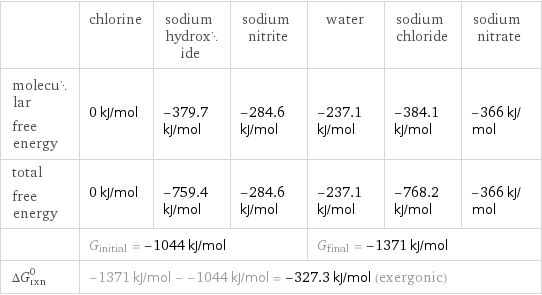
| chlorine | sodium hydroxide | sodium nitrite | water | sodium chloride | sodium nitrate molecular free energy | 0 kJ/mol | -379.7 kJ/mol | -284.6 kJ/mol | -237.1 kJ/mol | -384.1 kJ/mol | -366 kJ/mol total free energy | 0 kJ/mol | -759.4 kJ/mol | -284.6 kJ/mol | -237.1 kJ/mol | -768.2 kJ/mol | -366 kJ/mol | G_initial = -1044 kJ/mol | | | G_final = -1371 kJ/mol | | ΔG_rxn^0 | -1371 kJ/mol - -1044 kJ/mol = -327.3 kJ/mol (exergonic) | | | | |
Equilibrium constant
![Construct the equilibrium constant, K, expression for: Cl_2 + NaOH + NaNO_2 ⟶ H_2O + NaCl + NaNO_3 Plan: • Balance the chemical equation. • Determine the stoichiometric numbers. • Assemble the activity expression for each chemical species. • Use the activity expressions to build the equilibrium constant expression. Write the balanced chemical equation: Cl_2 + 2 NaOH + NaNO_2 ⟶ H_2O + 2 NaCl + NaNO_3 Assign stoichiometric numbers, ν_i, using the stoichiometric coefficients, c_i, from the balanced chemical equation in the following manner: ν_i = -c_i for reactants and ν_i = c_i for products: chemical species | c_i | ν_i Cl_2 | 1 | -1 NaOH | 2 | -2 NaNO_2 | 1 | -1 H_2O | 1 | 1 NaCl | 2 | 2 NaNO_3 | 1 | 1 Assemble the activity expressions accounting for the state of matter and ν_i: chemical species | c_i | ν_i | activity expression Cl_2 | 1 | -1 | ([Cl2])^(-1) NaOH | 2 | -2 | ([NaOH])^(-2) NaNO_2 | 1 | -1 | ([NaNO2])^(-1) H_2O | 1 | 1 | [H2O] NaCl | 2 | 2 | ([NaCl])^2 NaNO_3 | 1 | 1 | [NaNO3] The equilibrium constant symbol in the concentration basis is: K_c Mulitply the activity expressions to arrive at the K_c expression: Answer: | | K_c = ([Cl2])^(-1) ([NaOH])^(-2) ([NaNO2])^(-1) [H2O] ([NaCl])^2 [NaNO3] = ([H2O] ([NaCl])^2 [NaNO3])/([Cl2] ([NaOH])^2 [NaNO2])](../image_source/f571704890c7a095bbb368252fd99d66.png)
Construct the equilibrium constant, K, expression for: Cl_2 + NaOH + NaNO_2 ⟶ H_2O + NaCl + NaNO_3 Plan: • Balance the chemical equation. • Determine the stoichiometric numbers. • Assemble the activity expression for each chemical species. • Use the activity expressions to build the equilibrium constant expression. Write the balanced chemical equation: Cl_2 + 2 NaOH + NaNO_2 ⟶ H_2O + 2 NaCl + NaNO_3 Assign stoichiometric numbers, ν_i, using the stoichiometric coefficients, c_i, from the balanced chemical equation in the following manner: ν_i = -c_i for reactants and ν_i = c_i for products: chemical species | c_i | ν_i Cl_2 | 1 | -1 NaOH | 2 | -2 NaNO_2 | 1 | -1 H_2O | 1 | 1 NaCl | 2 | 2 NaNO_3 | 1 | 1 Assemble the activity expressions accounting for the state of matter and ν_i: chemical species | c_i | ν_i | activity expression Cl_2 | 1 | -1 | ([Cl2])^(-1) NaOH | 2 | -2 | ([NaOH])^(-2) NaNO_2 | 1 | -1 | ([NaNO2])^(-1) H_2O | 1 | 1 | [H2O] NaCl | 2 | 2 | ([NaCl])^2 NaNO_3 | 1 | 1 | [NaNO3] The equilibrium constant symbol in the concentration basis is: K_c Mulitply the activity expressions to arrive at the K_c expression: Answer: | | K_c = ([Cl2])^(-1) ([NaOH])^(-2) ([NaNO2])^(-1) [H2O] ([NaCl])^2 [NaNO3] = ([H2O] ([NaCl])^2 [NaNO3])/([Cl2] ([NaOH])^2 [NaNO2])
Rate of reaction
![Construct the rate of reaction expression for: Cl_2 + NaOH + NaNO_2 ⟶ H_2O + NaCl + NaNO_3 Plan: • Balance the chemical equation. • Determine the stoichiometric numbers. • Assemble the rate term for each chemical species. • Write the rate of reaction expression. Write the balanced chemical equation: Cl_2 + 2 NaOH + NaNO_2 ⟶ H_2O + 2 NaCl + NaNO_3 Assign stoichiometric numbers, ν_i, using the stoichiometric coefficients, c_i, from the balanced chemical equation in the following manner: ν_i = -c_i for reactants and ν_i = c_i for products: chemical species | c_i | ν_i Cl_2 | 1 | -1 NaOH | 2 | -2 NaNO_2 | 1 | -1 H_2O | 1 | 1 NaCl | 2 | 2 NaNO_3 | 1 | 1 The rate term for each chemical species, B_i, is 1/ν_i(Δ[B_i])/(Δt) where [B_i] is the amount concentration and t is time: chemical species | c_i | ν_i | rate term Cl_2 | 1 | -1 | -(Δ[Cl2])/(Δt) NaOH | 2 | -2 | -1/2 (Δ[NaOH])/(Δt) NaNO_2 | 1 | -1 | -(Δ[NaNO2])/(Δt) H_2O | 1 | 1 | (Δ[H2O])/(Δt) NaCl | 2 | 2 | 1/2 (Δ[NaCl])/(Δt) NaNO_3 | 1 | 1 | (Δ[NaNO3])/(Δt) (for infinitesimal rate of change, replace Δ with d) Set the rate terms equal to each other to arrive at the rate expression: Answer: | | rate = -(Δ[Cl2])/(Δt) = -1/2 (Δ[NaOH])/(Δt) = -(Δ[NaNO2])/(Δt) = (Δ[H2O])/(Δt) = 1/2 (Δ[NaCl])/(Δt) = (Δ[NaNO3])/(Δt) (assuming constant volume and no accumulation of intermediates or side products)](../image_source/83d66b48caad42575a085a6e25317e61.png)
Construct the rate of reaction expression for: Cl_2 + NaOH + NaNO_2 ⟶ H_2O + NaCl + NaNO_3 Plan: • Balance the chemical equation. • Determine the stoichiometric numbers. • Assemble the rate term for each chemical species. • Write the rate of reaction expression. Write the balanced chemical equation: Cl_2 + 2 NaOH + NaNO_2 ⟶ H_2O + 2 NaCl + NaNO_3 Assign stoichiometric numbers, ν_i, using the stoichiometric coefficients, c_i, from the balanced chemical equation in the following manner: ν_i = -c_i for reactants and ν_i = c_i for products: chemical species | c_i | ν_i Cl_2 | 1 | -1 NaOH | 2 | -2 NaNO_2 | 1 | -1 H_2O | 1 | 1 NaCl | 2 | 2 NaNO_3 | 1 | 1 The rate term for each chemical species, B_i, is 1/ν_i(Δ[B_i])/(Δt) where [B_i] is the amount concentration and t is time: chemical species | c_i | ν_i | rate term Cl_2 | 1 | -1 | -(Δ[Cl2])/(Δt) NaOH | 2 | -2 | -1/2 (Δ[NaOH])/(Δt) NaNO_2 | 1 | -1 | -(Δ[NaNO2])/(Δt) H_2O | 1 | 1 | (Δ[H2O])/(Δt) NaCl | 2 | 2 | 1/2 (Δ[NaCl])/(Δt) NaNO_3 | 1 | 1 | (Δ[NaNO3])/(Δt) (for infinitesimal rate of change, replace Δ with d) Set the rate terms equal to each other to arrive at the rate expression: Answer: | | rate = -(Δ[Cl2])/(Δt) = -1/2 (Δ[NaOH])/(Δt) = -(Δ[NaNO2])/(Δt) = (Δ[H2O])/(Δt) = 1/2 (Δ[NaCl])/(Δt) = (Δ[NaNO3])/(Δt) (assuming constant volume and no accumulation of intermediates or side products)
Chemical names and formulas
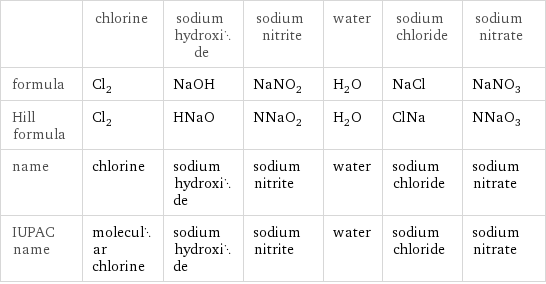
| chlorine | sodium hydroxide | sodium nitrite | water | sodium chloride | sodium nitrate formula | Cl_2 | NaOH | NaNO_2 | H_2O | NaCl | NaNO_3 Hill formula | Cl_2 | HNaO | NNaO_2 | H_2O | ClNa | NNaO_3 name | chlorine | sodium hydroxide | sodium nitrite | water | sodium chloride | sodium nitrate IUPAC name | molecular chlorine | sodium hydroxide | sodium nitrite | water | sodium chloride | sodium nitrate
Substance properties

| chlorine | sodium hydroxide | sodium nitrite | water | sodium chloride | sodium nitrate molar mass | 70.9 g/mol | 39.997 g/mol | 68.995 g/mol | 18.015 g/mol | 58.44 g/mol | 84.994 g/mol phase | gas (at STP) | solid (at STP) | solid (at STP) | liquid (at STP) | solid (at STP) | solid (at STP) melting point | -101 °C | 323 °C | 271 °C | 0 °C | 801 °C | 306 °C boiling point | -34 °C | 1390 °C | | 99.9839 °C | 1413 °C | density | 0.003214 g/cm^3 (at 0 °C) | 2.13 g/cm^3 | 2.168 g/cm^3 | 1 g/cm^3 | 2.16 g/cm^3 | 2.26 g/cm^3 solubility in water | | soluble | | | soluble | soluble surface tension | | 0.07435 N/m | | 0.0728 N/m | | dynamic viscosity | | 0.004 Pa s (at 350 °C) | | 8.9×10^-4 Pa s (at 25 °C) | | 0.003 Pa s (at 250 °C) odor | | | | odorless | odorless |
Units
